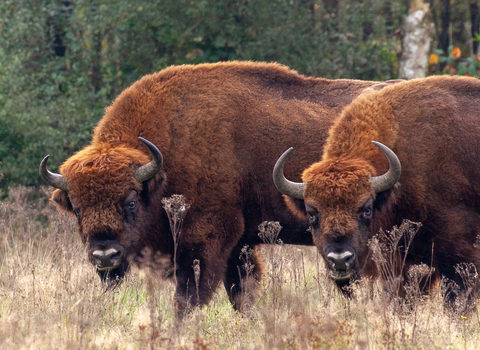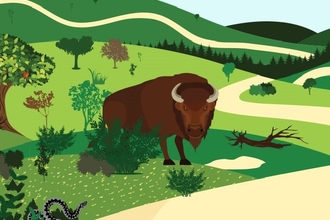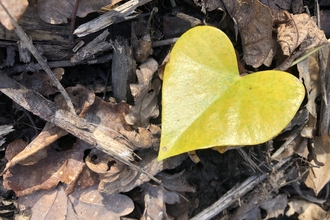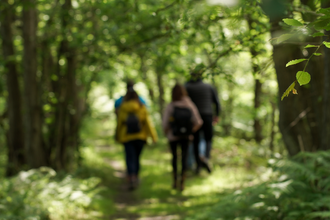An ecosystem engineer with unique skills
In July 2022, Kent Wildlife Trust and Wildwood Trust introduced three European bison into an area of West Blean and Thornden Woods as part of the Wilder Blean project. These animals will manage the habitat in a natural way that cannot be achieved through human management methods, creating a mosaic of habitats that will allow the woodland to regenerate and flourish.
Frequently Asked Questions
Why bison?
Bison manage habitats in a way that no other animal can. In Blean woods, we need to encourage more light to the woodland floor and increase the amount of deadwood to benefit native plants and animals, and this is exactly what the bison can do for us.
The way bison graze and interact with their surroundings is unique; targeting bark rather than other parts of a plant, creating ‘bull pits’ or ‘sand baths’ by dust bathing to remove parasites, removing moulting fur by rubbing against trees and due to their large size and strength, creating corridors through densely vegetated patches which in turn links up microhabitats. All these behaviours can create a healthy life cycle in woodland and create gaps in the canopy that provide a 3-dimensional habitat to the benefit of a variety of species. Without an animal like bison, these functions are missing in woodlands, and this project aims to restore those functions.
European bison are the closest living relative to a species which used to roam the UK several thousand years ago.
They are the best chance we have of restoring the function which was lost when the earlier species went extinct.
How will European bison help to improve the environment in the Blean?
These animals create a more diverse woodland with trees of different ages and clearings allowing native species to thrive. Together with re-wetting the site, this will increase the habitats’ resilience to climate change and allow more species to adapt to changing conditions.
Don't grazing animals like bison produce greenhouse gasses?
Although these grazing animals do produce methane, the way bison graze and the food they eat in the woodland produces less greenhouse gasses compared to traditional conservation grazers like sheep and cattle.
Did European bison ever live wild in the UK?
This is definitely one for debate. There is no confirmed record of European Bison in the UK but fossils of its close relative, Steppe Bison, have been found off the British coast. However, large herbivores like bison and aurochs (the primeval cattle) were in our landscapes, including our woodlands.
What is the difference between American and European bison?
Globally, there are two different types of bison alive today: European bison, and their cousins, American bison. They look quite similar, however they behave differently. American bison graze on the grass of wide and open plains whereas European bison are more adapted to woodlands. In this project, we are using European bison.
Although they look quite similar, in general, European bison are a little taller than American bison, with less dense fur, and American bison are a bit stockier than European bison. They feed differently to one another due to their necks being differently set - American bison will graze on low-lying grass and leafy vegetation, whereas European bison will browse on leaves, fruit, and woody parts of plants and trees, perfect for our UK woodlands. In the past, there were more species of bison that have now gone extinct. These are the only remaining species that can do the job they do.
What about other grazing animals, or native cattle, instead of bison?
We are going to monitor the relative benefits of using bison versus using long-horn cattle for woodland management in the Blean. The woods will be split into 3 areas (with bison, with cattle, and without either) and our ecologists will assess the impacts in each section.
Cows, horses and pigs will be freely roaming within the site. Cows and horses have been used for many years although now they will be grazing across the whole site. Pigs are a new addition but will be in very low numbers.
Bison provide a missing function within the ecosystem. The way bison interact with the land is different to other grazing animals we have in the UK, like horses or cows. For instance, horses will typically only eat softer grasses, cattle will eat soft vegetation as well as twigs, but only bison will typically target and eat bark in addition to grasses and sedges. This means that the effect bison have on trees is different to cows - bison feeding can ringbark and kill select trees, leaving room for others to come through. Bison also uniquely tend to rub up against select trees to remove their thick coat of winter fur, which has a similar effect. Pigs are fantastic at churning up soil and helping seeds to grow. It is when introduced all together that these animals can be most effective, and this is what we intend to do in the project.
Can't find the answer to your question?
If you have a question about European bison and can't find the answer, please get in touch. You can also keep an eye out on our social media where we regularly post our expert Q&As.



